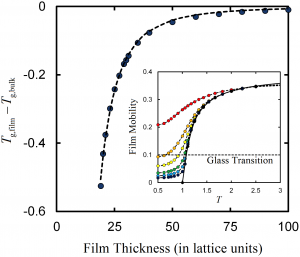Lattice Model of Mobility at Interfaces in Films and Fluid Bilayers
We have applied our simple kinetic lattice model of free volume and mobility in fluids to understand how interfaces, such as free surfaces, substrates, and fluid-fluid boundaries, influence the spatial structure of mobility in fluid films and bilayers. Near the free surface in a fluid film, mobility is enhanced near and past kinetic arrest, leading the film to have a suppressed effective kinetic arrest transition temperature compared to bulk equivalents.
 The inset image at right shows plots of film-averaged mobility (in the form of mobile free volume) as a function of temperature T for different film thicknesses (red to blue is films of increasing thickness, and black is a bulk sample). The outer image shows the deviation of the film’s kinetic arrest (glass transition) temperature from bulk as a function of film thickness. The prediction from our model strongly resembles experiments measuring the suppression of the glass transition temperature in ultra-thin (low-molecular-weight) supported films of polystyrene. To read about the details of this study, as well as our results for free volume and mobility in fluid bilayers, take a look at the publication here.
The inset image at right shows plots of film-averaged mobility (in the form of mobile free volume) as a function of temperature T for different film thicknesses (red to blue is films of increasing thickness, and black is a bulk sample). The outer image shows the deviation of the film’s kinetic arrest (glass transition) temperature from bulk as a function of film thickness. The prediction from our model strongly resembles experiments measuring the suppression of the glass transition temperature in ultra-thin (low-molecular-weight) supported films of polystyrene. To read about the details of this study, as well as our results for free volume and mobility in fluid bilayers, take a look at the publication here.

